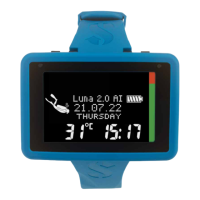25
English
LUNA 2.0 AI USER MANUAL
2.2.1.4 Time format
By entering the Format submenu, you can choose your preferred time format between AM/PM or 24-hour format.
Save your settings with the right button.
F
NOTE: Time format will also change the date format: mm/dd/yyyy in AM/PM format and dd.mm.yyyy in 24h
format. This change will affect, for example, the dates of your dives in your logbook.
2 .2 .2 User settings
In this menu you can customize your LUNA 2.0 AI to your liking. Settings like backlight duration, display contrast
and units can be changed here.
2.2.2.1 Workload
F
NOTE: The workload setting is only available when the adaptive algorithm (ZH-L16 ADT MB PMG) is selected
in the menu DECOALGO.
At the base of any decompression calculation there is the transport of nitrogen from the lungs to the blood and from
there to the tissues during on-gassing, and the same but in reverse during off-gassing. As such, it is obvious that
the single most important parameter in a decompression calculation is the rate at which blood travels through the
body. During heavy exercise, the total blood ow from the heart can be up to 4 times higher than while at rest. This
increase in blood ow is rather unevenly distributed, with some tissues such as the Central Nervous System and
the brain being unaffected, while others like the muscles receiving up to 10 times more blood than when at rest.
The LUNA 2.0 AI estimates workload based on heart rate or changes in breathing pattern from the high pressure
transmitter, and the decompression calculation in the ZH-L16 ADT model is changed accordingly. This menu allows
you to select the workload base or switch off the workload estimation, in which case your LUNA 2.0 AI will behave
like SCUBAPRO dive computer models without heart rate or air integration.
In the Workload menu you can scroll through the parameters, which are used to measure your workload during the
dive, using the pushbuttons. If you select HRT RATE, the heart rate limits can be edited. The maximum (MAX can
be selected from 140 to 220 bpm) heart rate is what you can reach under extreme exercise. If you don’t know your
maximum, a good approximation is given by subtracting your age (in years) from 220. The average light moving
base (BASE can be selected from 60 to 120 bpm) indicates the relaxed, unstressed dive heart rate average. Set the
values and save the setting by long-pressing the right button.

